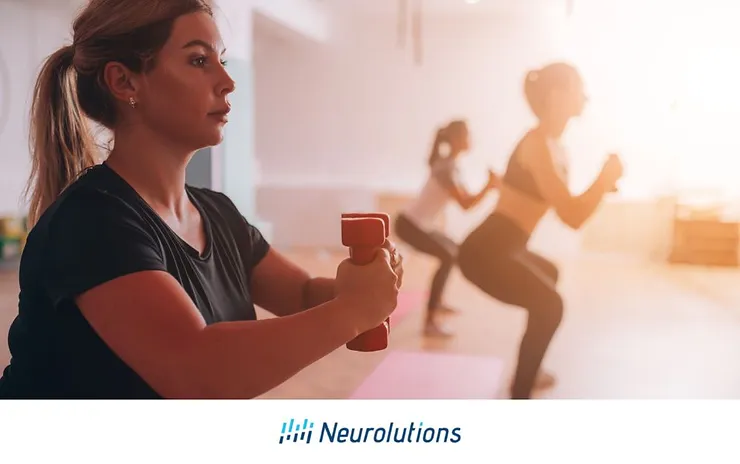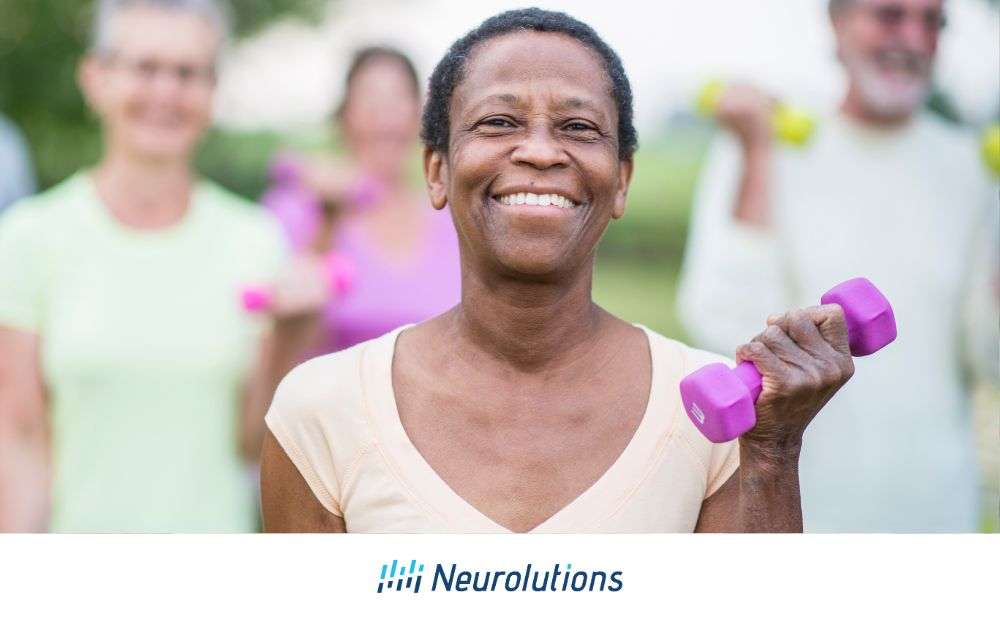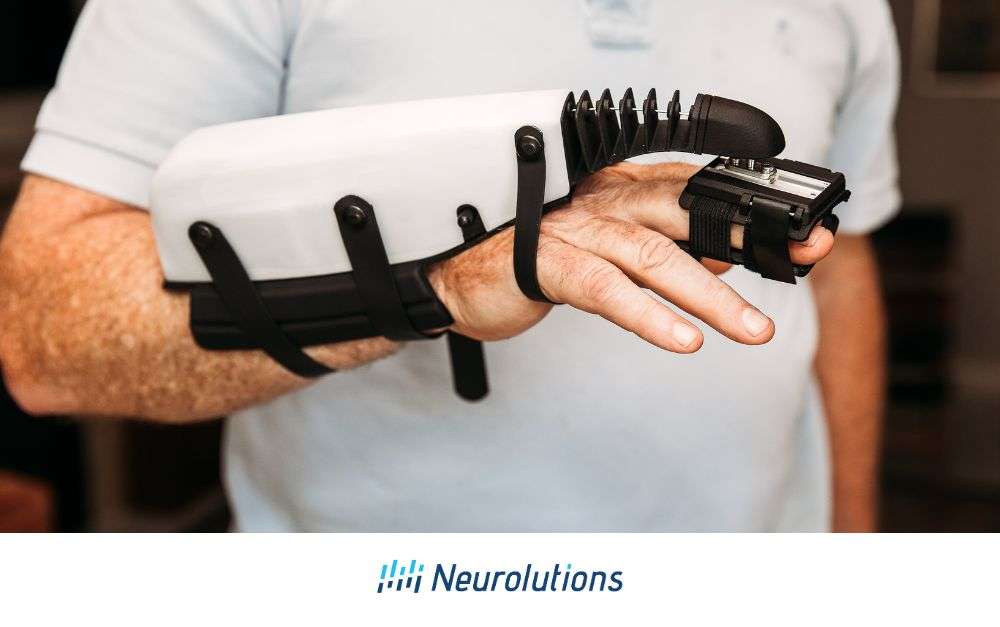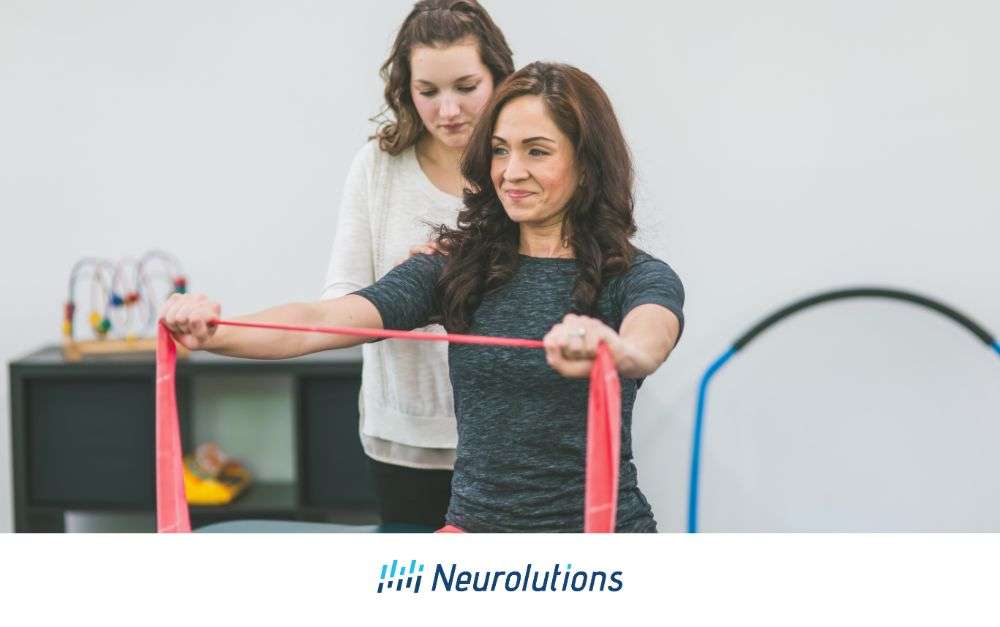Strokes are one prevalent example of a medical condition that contributes to disability, a decline in fitness and reduced mobility, impacting personal livelihood as well as those close to the individual. Strokes also take a toll on the health of our society, causing negative consequences such as the burden of health care costs, workforce reduction, reliance on medications, and hospital readmissions from the sequela of comorbidities that follow stroke symptoms.
Management and improvement of cardiovascular health and fitness after a stroke is included in best practice interventions, for both returning to the highest level of function possible and also preventing future strokes. This is in part due to a high percentage of individuals that suffer a stroke having cardiovascular conditions and other comorbidities that are associated with poor overall fitness.
Leading risk factors for heart disease and stroke are high blood pressure, high low-density lipoprotein (LDL) cholesterol, diabetes, smoking, and secondhand smoke exposure, obesity, unhealthy diet, and physical inactivity. Heart Disease and Stroke Statistics, CDC
Strokes Contribute to Reduced Physical Fitness and Inactivity
Stroke does not usually occur in isolation. A high prevalence of stroke survivors have pre-existing medical conditions, such as high blood pressure, diabetes, and coronary artery disease. (1)
According to the American Heart Association Stroke Council’s Scientific Statement Oversight Committee and the American Heart Association’s Manuscript Oversight Committee, “evidence suggests that stroke survivors experience physical deconditioning and lead sedentary lifestyles.”
|
• 40% have difficulties with basic self-care 6 months after stroke (e.g., dressing and feeding) • 30% of stroke survivors report participation restrictions (e.g., difficulty with autonomy, engagement, or fulfilling societal roles) even at 4 years post-stroke |
|
Post Stroke Consequences AHA/ASA Scientific Statement: Physical Activity and Exercise Recommendations for Stroke Survivors |
|
• Chronic sedentary lifestyle • Many have the ability to reach higher levels of physical activity but choose not to due to the lack of – awareness that exercise is feasible or desirable – access to resources to support exercise – structured exercise sessions |
“The recommendation from this writing group is that physical activity and exercise prescription should be incorporated into the management of stroke survivors.”
Views on Aerobic Exercise after Stroke: Past versus Present
Health sciences and rehabilitation research have come a long way in the last decade toward understanding the effects of aerobic exercise on an individual with a disease, chronic condition, or major medical episode such as a stroke.
In the past, researchers explored whether it was even safe for those that had a stroke to exercise in an aerobic manner.
The progression of research on aerobic exercise in the present day now investigates how often should aerobic exercise occur, how long should it be sustained, the type of aerobic exercise, how to make it accessible, and how to create sustainable programs that fit the unique needs of the individual.
The current view of aerobic and other modes of exercise that your healthcare provider would like you to adopt is…
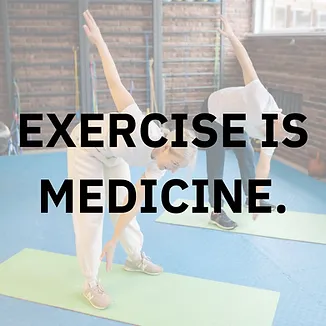
Just as one takes a prescription or non-prescription pharmaceutical compound for the treatment or prevention of disease, exercise is comparable to medicine because of the profound, positive impact it has on our mental, physical, and emotional well-being.
Exercise is vital to us as living creatures just as air and water are essential for our survival.
Exercise can be a prevention and oftentimes a remedy to a multitude of medical ailments and afflictions of our health.
Yes, exercise takes work. It also might be the last thing in the world you feel like doing if you have had a stroke. But, exercise can also save your life if done properly and in a routine that works for you.
Consider this debate:
Would you rather dedicate a small portion of your day to a progressive exercise program to take back control of your life, or would you rather play the game of risk with your health and future, where the stakes are high and consequences often amount to physical pain, mental suffering, and financial hardship for you and those around you?
The unfortunate reality is that most individuals choose the path of least resistance. This means they take the easy way out, making emotional decisions centered around what feels comfortable, safe, and easy.
This doesn’t have to be you or your loved one.
Learn more about aerobic and cardiovascular exercise after strokes in this article so you can start working on your journey to heart and brain health improvement through fitness.
What are the Benefits of Aerobic Exercises for Strokes?
Aerobic exercise training is recognized as a vital component in post-stroke rehabilitation. There are many benefits to aerobic exercise that relate to disease risk reduction. There also may be a correlation with the quality of life improvements due to enhanced physical performance, cognitive function, stress mitigation.
|
Proposed Exercise Risk Reduction AHA/ASA Scientific Statement: Physical Activity and Exercise Recommendations for Stroke Survivors |
|
• Lowers blood pressure • Decreases weight • Increases glucose tolerance • Improves lipid levels (fatty substance in the blood) • Reduces arterial inflammation • Improvement in maximal oxygen consumption (VO2max) (2) • Improvement of cognitive dysfunction at moderate intensity (3) • Elevation of BDNF (Brain-Derived Neurotrophic Factor), especially with high-intensity aerobic exercise (4) |
#BBD0E0
»
How Does Aerobic Exercise Help Reduce Lasting Ailments Following a Stroke?
Strokes contribute to decreased physical capacity. This is due to a combination of trauma in the brain, being bedridden from extended hospitalization, symptoms proceeding the stroke event, and disuse weakness.
Most stroke survivors do not recover physical capacity rapidly or easily. Muscle wasting occurs after 10 days of bed rest in healthy older adults. (5) For stroke survivors, the muscle-wasting process may be accelerated. Additionally, for every week that a patient rests in bed, they often require 2.5 weeks of rehabilitation inclusive of aerobic exercise. (6) To make matters worse, peak oxygen uptake (VO2 max) deteriorates by 0.8% for each day of bed rest. (7) Therefore, a longer period of inactivity amounts to detrimental effects on the cardiovascular system.
Concurrently, stroke survivors enter a vicious cycle where they get tired from doing activities because of reduced physical capacity, so they do not feel like doing as much. Therefore, their aerobic fitness plummets. Therefore, the cycle of fatigue, inactivity, and reduced aerobic capacity continues. Research indicates that they become at higher risk for falls and are predisposed to a sedentary lifestyle. (8, 9)
The response to breaking the cycle is to take measures to progressively improve physical capacity through aerobic exercises and everyday activities that promote cardiovascular fitness and muscle strength. Additionally, “physical activity goals and exercise prescription for stroke survivors need to be customized for the individual to maximize long-term adherence.” AHA/ASA Scientific Statement: Physical Activity and Exercise Recommendations for Stroke Survivors

How much exercise should I get after a stroke?
Aggressive exercising shortly after having a stroke (i.e. acute stage) is not advised and may actually be harmful. However, your doctors, nurses, or therapists may ask you to carefully move around to a safe and feasible level within 24 hours so your abilities can be evaluated. (10)
Once in the subacute phase (e.g. > 7 days), evidence supports exercising for improving cardiorespiratory fitness. Unfortunately, global guidelines for exercise in subacute stages post-stroke lack in-depth and technical information on exercise delivery methods, application, and dosage required to progress exercise interventions according to a 2022 systematic review. (11)
In the chronic phase of stroke (3-6+ months), it is recommended that structured exercise be delivered to improve overall health and complement recovery outcomes. How long, often, and what type of exercise will vary from survivor to survivor.
The most current American Heart Association (ASA) Recommendations for Physical Activity in Adults and Kids are as follows:
- Get at least 150 minutes per week of moderate-intensity aerobic activity or 75 minutes per week of vigorous aerobic activity, or a combination of both preferably spread throughout the week.
- Add moderate- to high-intensity muscle-strengthening activity (such as resistance or weights) at least 2 days per week.
Achieving recommendations of aerobic exercise as noted above levels is challenging for anyone- but especially stroke survivors! However, it doesn’t mean you cannot set a plan and do your best to stay disciplined with it.
In order to see any real functional gain, we know that aerobic exercise and strengthening need to occur at a minimum of 2-3 times per week at moderate intensity. You will need to adjust based on your fitness levels, your tolerance, and your goals.
What are the Best Cardio Exercises After Stroke?
A 2022 publication of a systematic review concluded that high-intensity interval training was more efficient than continuous aerobic training to gain cardiorespiratory fitness, balance, and gait speed in post-stroke patients. (12)
High-intensity interval training, or HITT, is a specific type of aerobic and/or resistance training that alternates between high-intensity movements that spike the heart rate, followed by shorter periods of rest and/or lower-intensity movements.
Cardiovascular Exercise after Stroke: What Should You Do?
Getting around- and getting safe and necessary aerobic exercise- is tough with a stroke.
However, the list of modalities of exercise appropriate for those rehabilitating from a stroke is not drastically different for those in the “healthy” population.
Here are some options for getting aerobic exercise if you have had a stroke. As noted above, there are benefits to incorporating intervals of higher-intensity bursts followed by lower-intensity periods.
Therefore, consider embracing HITT sessions with any of these forms of exercise!
Walking
Walking is an essential component of functional mobility and getting around in everyday life. Aerobic training is needed to build functional capacity so you can walk for long distances and ambulate within the community. Assistive devices, bracing, or advanced technology tools may be needed (read more about aerobic exercise with hemiplegia below).
There are many different environments in which a survivor can begin a walking program.
While each stroke survivor will need to consider the environment, intensity, duration, and level of assistance that is right for them, here are some walking options to consider:
- Treadmill training (with or without harness)
- Walk through planned-out routes in the household
- Walking on an indoor or outdoor track
- Walking in the neighborhood
- Walking through park or trail system, paved or unpaved
- Walking through a range of crowds and obstacles in the community
Recumbent Bike
A recumbent bike is a piece of exercise equipment that offers a lower and wider seat than a traditional bicycle. This makes it easier to transfer on and off for most people. Recumbent bikes provide back support and either a traditional 360-revolution for the lower extremity or a push/pull movement. Because of the high level of support once on the bike, even those experiencing problems with balance can still get an excellent cardiovascular workout. There are also arm bikes available at many rehabilitation facilities and community guy which can be incorporated into upper extremity exercise even with weakness.
Cycling
Cycling programs can be accomplished on a stationary exercise bike, a two-wheeled bike, or even an adapted bike (3-wheeled tricycle). Look for programs in your local area where an instructor can both guide and challenge you. If you would rather do it on your own, consider investing in a bike for your household. Modern programs (i.e. Peloton) offer virtual instruction at a monthly fee. There are also bikes that provide interesting visuals to hold your attention and raise the enjoyment of the experience.
If you are a beginner cyclist or are just starting your aerobic fitness journey, cycling on a stationary exercise bike can be a safe option that still offers tremendous benefits to the cardiovascular and neuromuscular systems. Interestingly, a highly acclaimed study found out that cycling has carryover benefits to mobility outside of cycling- walking!
Reported in the Archives of Physical Medicine and Rehabilitation in 2020, a 3x/week for 8-week aerobic cycling intervention targeting 60-80% heart rate max led to significant improvements in walking capacity in our cohort of individuals with chronic stroke. (13)
If you have the visual skills, balance, and confidence to ride outdoors, cycling outdoors has a lot of benefits outside of raising aerobic fitness, such as stimulating the nervous system with the “optic flow” of the world passing by, fresh air, and enhancement of motor skills.
Wheelchair Exercise
For those that are temporarily in a wheelchair- or even long term- you can get cardiovascular exercise. Moving your arms and legs with or without weights or resistance bands will get your heart rate up. You can also propel yourself forward or backward in the chair using your arms, legs, or both arms and legs. Include transfers in and out of your chair into the program to address both trunk control and lower body strength, but also functional transitioning between sitting and standing.
Exercises in a wheelchair can be quite challenging if you work up to a degree of intensity and challenge. Consider the athleticism required to compete in the Paralympic Games. There may also be local clubs in your area that host basketball, volleyball, lacrosse, etc from the level of the wheelchair.
Task-oriented Exercise
In task-oriented exercise, gains in function are achieved through specific activities that train to the task. In other words, real-life activities are performed in the format of the exercise. The goal is to enhance a skill while still reaping the benefits of increased cardiovascular-metabolic fitness, muscle strengthening, neuroplasticity, and acquiring motor skills.
Examples of task-oriented exercise may include a “circuit” or mass repetitions of getting up and sitting down, reaching to cupboards at different elevations, walking around obstacles, picking up items on the floor, stepping in patterns that resemble sweeping or raking, and combining movements of the arms, legs, and trunk as if you are making the bed.
If you want to try task-oriented exercises, start by selecting a few goal-specific activities. Decide where you want to do them and if you are going to incorporate objects or features of your natural living environment. Next, decide if you want to perform the activities for a specific length of time or if you want to count repetitions. Use a timer to stay on track. Incorporate rest breaks in between sets or as needed.
Swimming, Dancing, Zumba, Boxing, Agility Courses, Kayaking, Cardio Drumming
Safe participation in these forms of aerobic exercise is entirely possible for stroke survivors that have enough mobility. Modifications can always be incorporated, but you may require skilled guidance from a professional instructor that is trained in stroke rehabilitation or adaptive exercise programs. Many communities have adapted programs.
What is a Good Cardiovascular Activity for People with Hemiplegia?
Hemiplegia is a clinical presentation that occurs post-stroke in which an individual has symptoms of weakness on one side of the body (upper limb, lower limb, or both). Functional complications of hemiplegia can be difficulty manipulating objects with the affected limb, doing tasks two-handed, walking deficits, and having mobility issues. In particular, hemiparetic gait increases fall risk and promotes a sedentary lifestyle. “These events propagate disability by physical deconditioning and ‘learned non-use,’ with further functional declines accelerated by the sarcopenia and fitness decrements of advancing age.” (14)
If you have symptoms of hemiplegia, it can be challenging to exercise like a “normal” person.
Even with hemiplegia here are some suggestions for getting your heart rate elevated, building muscle, and aerobic fitness while mitigating risk for injury. As you may notice, these are similar to the cardio exercises as mentioned above, but with some special modifications.
Walking with Hemiplegia
- While you may require an assistive device (i.e. cane or walker) as well as special bracing for your lower extremity (i.e. AFO, KAFO, robotics), walking programs are still essential for those with hemiplegia or hemiparesis. Use assistance from skilled therapy professionals (PT/OT) to optimize your gait pattern, but if necessary, ensure a family member is around to assist you with a gait belt.
- Robotic exoskeletons are available at many rehabilitation centers to facilitate a more “normal” walking pattern. Some robotic exoskeletons are also designed for home use.
- Electrical stimulation (i.e. NMES, FES, ES) is a commonly used modality in lower extremity stroke rehabilitation. Although commercial devices offer different delivery modes and patterns of stimulation, your therapist can show you how to use them to assist your weaker leg while walking.
Cycling with Hemiplegia
- Try a recumbent bike first
- If the recumbent bike has handles, wrap your weak hand on the arm handle using ace wrap or glove. If you have subluxation, instability, or pain in your shoulder, be very careful not to overextend your arm due to the push/pull force imposed by your legs. This can be highly dangerous. Let your arm be what dictates how hard your legs work. The lower extremity is not as predisposed to damage as much as the arm, so remember to focus on your affected arm. Engage and contract your arm muscles while working and be very attentive to signs and signals of instability.
- If it is your leg that cannot remain in optimal alignment because your hip rotates outward, consider tying a wrap or band just above your knees to keep your hip, knee, and ankle in the same plane. If your hip and knee turn in, a ball (approximately the size of a volleyball) placed between your thighs may help keep your weaker leg from internal rotation.
- Special bikes with functional electrical stimulation (FES bikes) may help stimulate designated muscle groups at the appropriate time to facilitate the movement pattern and “wake your muscles up.” In turn, this may help you work harder so your heart rate climbs to the desired aerobic threshold.
- Progress to an upright stationary bike once you have enough strength, balance, and stability
- Once determined to have a low risk for falls, you may be appropriate for a traditional bike.
- Remember that even the healthy population has a risk of falling off a bike. However, if you and your care team determine you are ready, ensure you begin on a flat surface and always wear a protective helmet.
Wheelchair Exercises with Hemiplegia
- Adaptations will be necessary with hemiplegia, but it should not stop you from trying. Your arm and legs will get stronger from the demands placed on your muscles as well as your heart and lungs.
Task-Oriented Exercise with Hemiplegia
Task-oriented exercise is an excellent way to improve aerobic fitness while simultaneously encouraging the hemiparetic limb to perform a functional task. Build a “circuit” routine and try to keep your heart rate elevated. Always select tasks and movements that are not going to risk injury.
Here are some general ideas to get you started:
- If you have enough movement in your hemiparetic upper limb, try to “force” the use of the limb by doing reach, grasp, and manipulation tasks with one hand. Use an oven mitt on your stronger hand to avoid the temptation to involve it in the task. Examples of a sequence of steps may include filling a cup with water, wiping down countertops, and opening and closing doors.
- If you intend to use both hands or both legs during the task (known as bilateral), ideas include squatting to pick items from low surfaces, shifting body weight side to side while reaching into cupboards, folding clothes, or drying dishes.
- Any of the above aerobic exercises can be incorporated into a task and can be effective for building stamina, activity tolerance, strength, and motor control.
References
- Furie KL, Kasner SE, Adams RJ, Albers GW, Bush RL, Fagan SC, Halperin JL, Johnston SC, Katzan I, Kernan WN, Mitchell PH, Ovbiagele B, Palesch YY, Sacco RL, Schwamm LH, Wassertheil-Smoller S, Turan TN, Wentworth D ; on behalf of the American Heart Association Stroke Council, Council on Cardiovascular Nursing, Council on Clinical Cardiology, and Interdisciplinary Council on Quality of Care and Outcomes Research. Guidelines for the prevention of stroke in patients with stroke or transient ischemic attack: a guideline for healthcare professionals from the American Heart Association/American Stroke Association. Stroke. 2011; 42:227–276
- Potempa K, Braun LT, Tinknell T, Popovich J. Benefits of aerobic exercise after stroke. Sports Med. 1996 May;21(5):337-46. doi: 10.2165/00007256-199621050-00003. PMID: 8724202.
- Li, Xiaogang PhDa,b; Geng, Di PhDc,*; Wang, Siyue MAc; Sun, Guotao PhDd. Aerobic exercises and cognitive function in post-stroke patients: A systematic review with meta-analysis. Medicine 101(41):p e31121, October 14, 2022.
- Ashcroft SK, Ironside DD, Johnson L, Kuys SS, Thompson-Butel AG. Effect of Exercise on Brain-Derived Neurotrophic Factor in Stroke Survivors: A Systematic Review and Meta-Analysis. Stroke. 2022 Dec;53(12):3706-3716. doi: 10.1161/STROKEAHA.122.039919. Epub 2022 Oct 24. PMID: 36278401.
- Kortebein P, et al. Functional impact of 10 days of bed rest in healthy older adults. J Gerontol A Biol Sci Med Sci. 2008;63(10):1076–1081. doi: 10.1093/gerona/63.10.1076
- Muller E. Influence of training and inactivity on muscle strength. Arch Phys Med Rehabil. 1970; 51: 449-62.
- Convertino VA. Cardiovascular consequences of bed rest: effect on maximal oxygen uptake. Med Sci Sports Exerc. 1997 Feb;29(2):191-6. doi: 10.1097/00005768-199702000-00005. PMID: 9044222.
- Physical Activity and Exercise Recommendations for Stroke Survivors A Statement for Healthcare Professionals From the American Heart Association/American Stroke Association
- Sandra A. Billinger, Ross Arena, Julie Bernhardt, Janice J. Eng, Barry A. Franklin, Cheryl Mortag Johnson, Marilyn MacKay-Lyons, Richard F. Macko, Gillian E. Mead, Elliot J. Roth, Originally published 20 May 2014 https://doi.org/10.1161/STR.0000000000000022Stroke. 2014;45:2532–2553
- Lee H, Yun HJ, Ding Y. Timing is everything: Exercise therapy and remote ischemic conditioning for acute ischemic stroke patients. Brain Circ. 2021 Aug 27;7(3):178-186. doi: 10.4103/bc.bc_35_21. PMID: 34667901; PMCID: PMC8459690.
- Church G, Ali A, Smith CL, Broom D, Sage K. Examining Clinical Practice Guidelines for Exercise and Physical Activity as Part of Rehabilitation for People with Stroke: A Systematic Review. Int J Environ Res Public Health. 2022 Feb 2;19(3):1707. doi: 10.3390/ijerph19031707. PMID: 35162730; PMCID: PMC8835364.
- Anjos JM, Neto MG, dos Santos FS, et al. The impact Of high-intensity interval training On functioning And health-related quality Of life In post-stroke patients: A systematic review With meta-analysis. Clinical Rehabilitation. 2022;36(6):726-739. doi:10.1177/02692155221087082.
- Linder SM, Davidson S, Rosenfeldt A, Lee J, Koop MM, Bethoux F, Alberts JL. Forced and Voluntary Aerobic Cycling Interventions Improve Walking Capacity in Individuals With Chronic Stroke. Arch Phys Med Rehabil. 2021 Jan;102(1):1-8. doi: 10.1016/j.apmr.2020.08.006. Epub 2020 Sep 9. PMID: 32918907; PMCID: PMC7796862.
- Macko RF, Ivey FM, Forrester LW. Task-oriented aerobic exercise in chronic hemiparetic stroke: training protocols and treatment effects. Top Stroke Rehabil. 2005 Winter;12(1):45-57. doi: 10.1310/PJQN-KAN9-TTVY-HYQH. PMID: 15736000.
Physical Activity and Exercise Recommendations For Stroke Survivors

